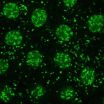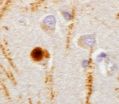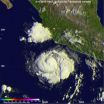(Press-News.org) The "Goldilocks effect" in fruit fly embryos may be more intricate than previously thought. It's been known that specific proteins, called histones, must exist within a certain range—if there are too few, a fruit fly's DNA is damaged; if there are too many, the cell dies. Now research out of the University of Rochester shows that different types of histone proteins also need to exist in specific proportions. The work further shows that cellular storage facilities keep over-produced histones in reserve until they are needed.
Associate Professor of Biology Michael Welte has discovered that the histone balance is regulated by those storage facilities, called lipid droplets—which are best known as fat depots.
The findings were published today in the journal Current Biology.
Welte had previously discovered that another protein—called Jabba—anchored histones onto lipid droplets. In his latest research, he found that excess histones migrate outside the nucleus to the droplets, where they are temporarily held until needed to create new chromosomes.
"People have observed histone proteins on lipid droplets in multiple organisms, including mammals," said Welte. "The results of this research project may very well help us understand the role of histones and lipid droplets in humans."
Welte found that by deleting the Jabba anchors from the cell, one particular type of histone increased in proportion in the nucleus, since they had no way to be held in reserve away from the cell nuclei. That made the embryo more sensitive to environmental stresses like higher temperature, leading to defects during cell division and reduced viability.
Just as it is in humans, the embryonic stage is a crucial time for the fruit fly (Drosophila melanogaster). Starting from a single cell, it has to rapidly multiply in cell number and develop into a larva while coping with stresses from the environment. The embryo does all of that by activating a myriad of genetic on-off switches, a process that involves unwrapping and rewrapping various regions of DNA.
Histones are important to the process because they act as spools that DNA molecules wrap around to form chromosomes, making it possible for the DNA to do its work in the first place. Welte discovered that if the different histones are not in the correct proportion, the embryo has trouble developing correctly and may even die.
Achieving the correct proportion of histones is not something that happens automatically in the fruit fly embryo, as Welte found in his research. Instead, when a certain histone type is made in excess, it is redirected to the lipid-droplet holding sites outside the nucleus where it is kept until needed.
Welte and his team will try next to identify which parts of the Jabba protein actually bind with the histone. Once that's determined, scientists may have the ability to manipulate the histone storage process.
"Since histones and lipid droplets are found in humans, I very much expect that there will be a similar storage process," said Welte. "If that is the case, our findings could one day help treat or prevent diseases linked to chromosome malfunction. What I find most fascinating is that our research uncovered this intimate link between cellular fat depots and the nucleus, a connection that just a few years ago nobody would have dreamt of. "
INFORMATION:
The research team included Zhihuan Li, Matthew Johnson, Zhonghe Ke and Lili Chen. The research was supported by a grant from the National Institutes of Health.
Protein anchors help keep embryonic development 'just right'
2014-06-12
ELSE PRESS RELEASES FROM THIS DATE:
Penn study describes new models for testing Parkinson's disease immune-based drugs
2014-06-12
PHILADELPHIA - Using powerful, newly developed cell culture and mouse models of sporadic Parkinson's disease (PD), a team of researchers from the Perelman School of Medicine at the University of Pennsylvania, has demonstrated that immunotherapy with specifically targeted antibodies may block the development and spread of PD pathology in the brain. By intercepting the distorted and misfolded alpha-synuclein (α-syn) proteins that enter and propagate in neurons, creating aggregates, the researchers prevented the development of pathology and also reversed some of the ...
Viral infections, including flu, could be inhibited by naturally occurring protein
2014-06-12
PITTSBURGH, June 12, 2014 – By boosting a protein that naturally exists in our cells, an international team of researchers led by the University of Pittsburgh Cancer Institute (UPCI), partner with UPMC CancerCenter, has found a potential way to enhance our ability to sense and inhibit viral infections.
The laboratory-based discovery, which could lead to more effective treatments for viruses ranging from hepatitis C to the flu, appears in the June 19 issue of the journal Immunity. The research is supported by the National Institutes of Health.
"Despite remarkable advances ...
African-Americans respond better to first-line diabetes drug than whites
2014-06-12
Washington, DC—African Americans taking the diabetes drug metformin saw greater improvements in their blood sugar control than white individuals who were prescribed the same medication, according to a new study published in the Endocrine Society's Journal of Clinical Endocrinology & Metabolism (JCEM).
An estimated 29 million Americans have diabetes. African Americans are twice as likely to be diagnosed with diabetes as whites and have a higher rate of complications such as kidney failure, according to the U.S. Department of Health and Human Services' Office of Minority ...
Brain power
2014-06-12
VIDEO:
Real-time movie of changes in total hemoglobin in the brain during stimulation. The initial blush of the brain is followed quickly by dilation (red) of arteries on the brain's surface....
Click here for more information.
New York, NY—June 12, 2014—In a new study published online in the Journal of the American Heart Association June 12, 2014, researchers at Columbia Engineering report that they have identified a new component of the biological mechanism that controls ...
Time-lapse study reveals bottlenecks in stem cell expansion
2014-06-12
A time-lapse study of human embryonic stems cells has identified bottlenecks restricting the formation of colonies, a discovery that could lead to improvement in their use in regenerative medicine.
Biologists at the University of Sheffield's Centre for Stem Cell Biology led by Professor Peter Andrews and engineers in the Complex Systems and Signal Processing Group led by Professor Daniel Coca studied human pluripotent stem cells, which are a potential source of cells for regenerative medicine because they have the ability to produce any cell type in the body.
However, ...
Synchronized brain waves enable rapid learning
2014-06-12
CAMBRIDGE, MA -- The human mind can rapidly absorb and analyze new information as it flits from thought to thought. These quickly changing brain states may be encoded by synchronization of brain waves across different brain regions, according to a new study from MIT neuroscientists.
The researchers found that as monkeys learn to categorize different patterns of dots, two brain areas involved in learning — the prefrontal cortex and the striatum — synchronize their brain waves to form new communication circuits.
"We're seeing direct evidence for the interactions between ...
Scientists find trigger to decode the genome
2014-06-12
Scientists from The University of Manchester have identified an important trigger that dictates how cells change their identity and gain specialised functions.
And the research, published today in Cell Reports, has brought them a step closer to being able to decode the genome.
The scientists have found out how embryonic stem cell fate is controlled which will lead to future research into how cells can be artificially manipulated.
Lead author Andrew Sharrocks, Professor in Molecular Biology at The University of Manchester, said: "Understanding how to manipulate cells ...
12 minutes of exercise improves attention, reading comprehension in low-income adolescents
2014-06-12
HANOVER, N.H. – June 12, 2014 – A new Dartmouth study Dartmouth study shows 12 minutes of exercise can improve attention and reading comprehension in low-income adolescents, suggesting that schools serving low-income populations should work brief bouts of exercise into their daily schedules.
The study, published as part of the June volume of Frontiers in Psychology, compared low-income adolescents with their high-income peers. While both groups saw improvement in selective visual attention up to 45 minutes after exercising, the low-income group experienced a bigger jump. ...
Opioid use prior to spine surgery linked to diminished patient reported outcomes
2014-06-12
ROSEMONT, Ill.─A new study appearing in the Journal of Bone and Joint Surgery (JBJS) links the use of opioid pain relievers (prescription medications, such as Percocet) to less improvement and higher levels of dissatisfaction following spine surgery.
Between 1999 and 2010, a greater focus on pain management resulted in a four-fold increase in opioids sold to hospitals, pharmacies and doctors' offices, and a related and ongoing increase in opioid-related complications, including opioid dependence, impaired cognition and poor treatment outcomes. Previous studies have ...
NASA and NOAA satellites analyze Category 4 Hurricane Cristina
2014-06-12
VIDEO:
On June 11, NASA's TRMM satellite found rain falling at a rate of over 74.4 mm/2.9 inches per hour in a strong feeder band east of Hurricane Cristina's eye.Another area...
Click here for more information.
A fleet of satellites from NASA and NOAA are on the job monitoring the first major hurricane of the Eastern Pacific Ocean Season as Hurricane Cristina has reached Category 4 status on the Saffir-Simpson scale.
This morning, June 12, at 1200 UTC (8 a.m. EDT), NOAA's GOES-West ...



